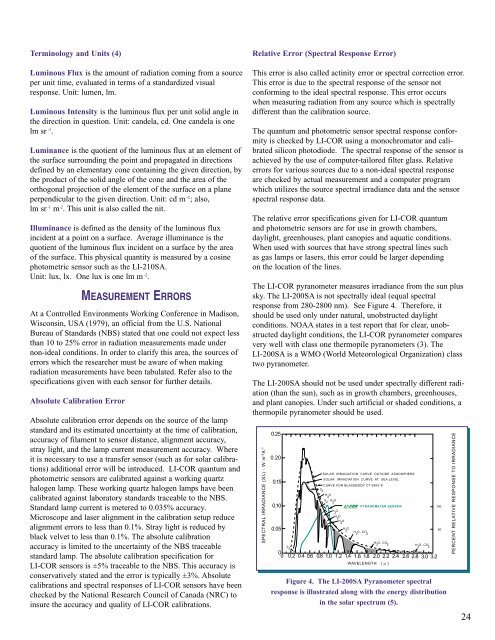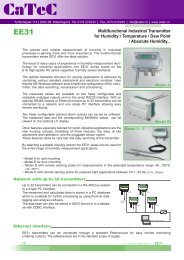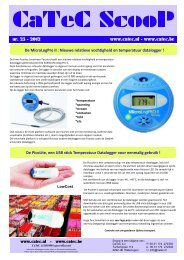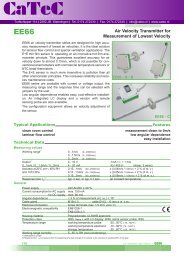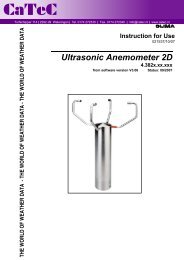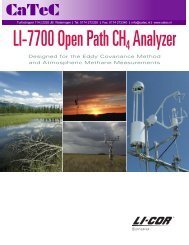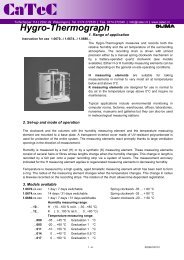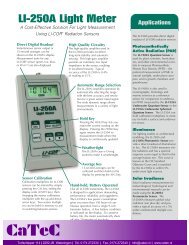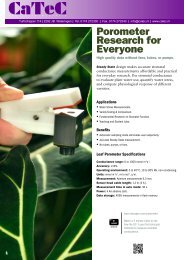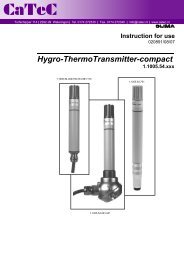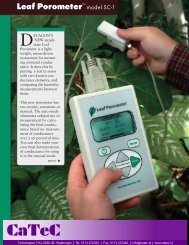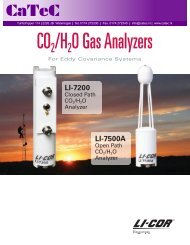li-190sa quantum sensor li-190sa quantum sensor
li-190sa quantum sensor li-190sa quantum sensor
li-190sa quantum sensor li-190sa quantum sensor
You also want an ePaper? Increase the reach of your titles
YUMPU automatically turns print PDFs into web optimized ePapers that Google loves.
ENVIRONMENTAL DIVISION<br />
Terminology and Units (4)<br />
Luminous Flux is the amount of radiation coming from a source<br />
per unit time, evaluated in terms of a standardized visual<br />
response. Unit: lumen, lm.<br />
Luminous Intensity is the luminous flux per unit so<strong>li</strong>d angle in<br />
the direction in question. Unit: candela, cd. One candela is one<br />
lm sr -1 .<br />
Luminance is the quotient of the luminous flux at an element of<br />
the surface surrounding the point and propagated in directions<br />
defined by an elementary cone containing the given direction, by<br />
the product of the so<strong>li</strong>d angle of the cone and the area of the<br />
orthogonal projection of the element of the surface on a plane<br />
perpendicular to the given direction. Unit: cd m -2 ; also,<br />
lm sr -1 m -2 . This unit is also called the nit.<br />
Illuminance is defined as the density of the luminous flux<br />
incident at a point on a surface. Average illuminance is the<br />
quotient of the luminous flux incident on a surface by the area<br />
of the surface. This physical quantity is measured by a cosine<br />
photometric <strong>sensor</strong> such as the LI-210SA.<br />
Unit: lux, lx. One lux is one lm m -2 .<br />
MEASUREMENT ERRORS<br />
At a Controlled Environments Working Conference in Madison,<br />
Wisconsin, USA (1979), an official from the U.S. National<br />
Bureau of Standards (NBS) stated that one could not expect less<br />
than 10 to 25% error in radiation measurements made under<br />
non-ideal conditions. In order to clarify this area, the sources of<br />
errors which the researcher must be aware of when making<br />
radiation measurements have been tabulated. Refer also to the<br />
specifications given with each <strong>sensor</strong> for further details.<br />
Absolute Ca<strong>li</strong>bration Error<br />
Absolute ca<strong>li</strong>bration error depends on the source of the lamp<br />
standard and its estimated uncertainty at the time of ca<strong>li</strong>bration,<br />
accuracy of filament to <strong>sensor</strong> distance, a<strong>li</strong>gnment accuracy,<br />
stray <strong>li</strong>ght, and the lamp current measurement accuracy. Where<br />
it is necessary to use a transfer <strong>sensor</strong> (such as for solar ca<strong>li</strong>brations)<br />
additional error will be introduced. LI-COR <strong>quantum</strong> and<br />
photometric <strong>sensor</strong>s are ca<strong>li</strong>brated against a working quartz<br />
halogen lamp. These working quartz halogen lamps have been<br />
ca<strong>li</strong>brated against laboratory standards traceable to the NBS.<br />
Standard lamp current is metered to 0.035% accuracy.<br />
Microscope and laser a<strong>li</strong>gnment in the ca<strong>li</strong>bration setup reduce<br />
a<strong>li</strong>gnment errors to less than 0.1%. Stray <strong>li</strong>ght is reduced by<br />
black velvet to less than 0.1%. The absolute ca<strong>li</strong>bration<br />
accuracy is <strong>li</strong>mited to the uncertainty of the NBS traceable<br />
standard lamp. The absolute ca<strong>li</strong>bration specification for<br />
LI-COR <strong>sensor</strong>s is ±5% traceable to the NBS. This accuracy is<br />
conservatively stated and the error is typically ±3%. Absolute<br />
ca<strong>li</strong>brations and spectral responses of LI-COR <strong>sensor</strong>s have been<br />
checked by the National Research Council of Canada (NRC) to<br />
insure the accuracy and qua<strong>li</strong>ty of LI-COR ca<strong>li</strong>brations.<br />
Relative Error (Spectral Response Error)<br />
This error is also called actinity error or spectral correction error.<br />
This error is due to the spectral response of the <strong>sensor</strong> not<br />
conforming to the ideal spectral response. This error occurs<br />
when measuring radiation from any source which is spectrally<br />
different than the ca<strong>li</strong>bration source.<br />
The <strong>quantum</strong> and photometric <strong>sensor</strong> spectral response conformity<br />
is checked by LI-COR using a monochromator and ca<strong>li</strong>brated<br />
si<strong>li</strong>con photodiode. The spectral response of the <strong>sensor</strong> is<br />
achieved by the use of computer-tailored filter glass. Relative<br />
errors for various sources due to a non-ideal spectral response<br />
are checked by actual measurement and a computer program<br />
which uti<strong>li</strong>zes the source spectral irradiance data and the <strong>sensor</strong><br />
spectral response data.<br />
The relative error specifications given for LI-COR <strong>quantum</strong><br />
and photometric <strong>sensor</strong>s are for use in growth chambers,<br />
day<strong>li</strong>ght, greenhouses, plant canopies and aquatic conditions.<br />
When used with sources that have strong spectral <strong>li</strong>nes such<br />
as gas lamps or lasers, this error could be larger depending<br />
on the location of the <strong>li</strong>nes.<br />
The LI-COR pyranometer measures irradiance from the sun plus<br />
sky. The LI-200SA is not spectrally ideal (equal spectral<br />
response from 280-2800 nm). See Figure 4. Therefore, it<br />
should be used only under natural, unobstructed day<strong>li</strong>ght<br />
conditions. NOAA states in a test report that for clear, unobstructed<br />
day<strong>li</strong>ght conditions, the LI-COR pyranometer compares<br />
very well with class one thermopile pyranometers (3). The<br />
LI-200SA is a WMO (World Meteorological Organization) class<br />
two pyranometer.<br />
The LI-200SA should not be used under spectrally different radiation<br />
(than the sun), such as in growth chambers, greenhouses,<br />
and plant canopies. Under such artificial or shaded conditions, a<br />
thermopile pyranometer should be used.<br />
SPECTRAL IRRADIANCE (Sλ) - W m -2 A -1<br />
0.25<br />
0.20<br />
0.15<br />
0.10<br />
0.05<br />
SOLAR IRRADIATION CURVE OUTSIDE ATMOSPHERE<br />
SOLAR IRRADIATION CURVE AT SEA LEVEL<br />
CURVE FOR BLACKBODY CT 5900°K<br />
0 3<br />
H O 2<br />
0 H O 2 2<br />
® PYRANOMETER SENSOR<br />
H O 2<br />
H O 2H<br />
O<br />
2<br />
H O 2<br />
H O, CO<br />
2 2<br />
0 3<br />
50<br />
H O, CO<br />
2 2 H O, CO<br />
2 2<br />
0 0 0.2 0.4 0.6 0.8 1.0 1.2 1.4 1.6 1.8 2.0 2.2 2.4 2.6 2.8 3.0 3.2<br />
WAVELENGTH ( µ )<br />
Figure 4. The LI-200SA Pyranometer spectral<br />
response is illustrated along with the energy distribution<br />
in the solar spectrum (5).<br />
100<br />
PERCENT RELATIVE RESPONSE TO IRRADIANCE<br />
24


